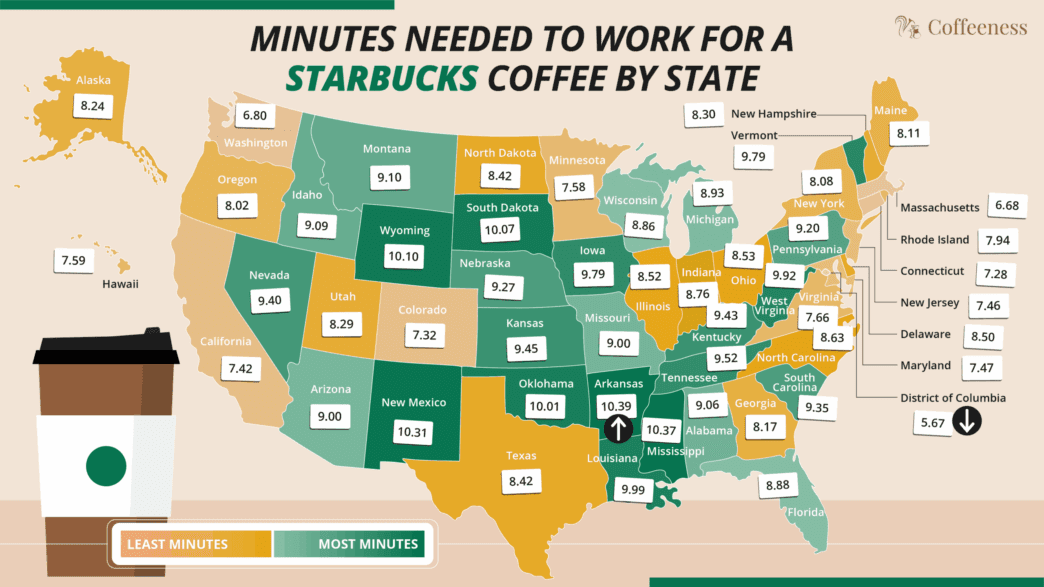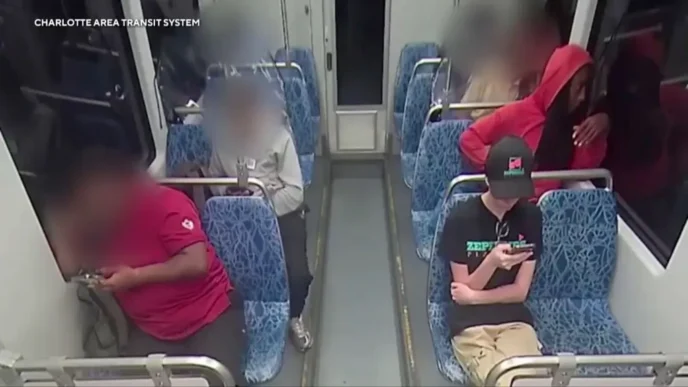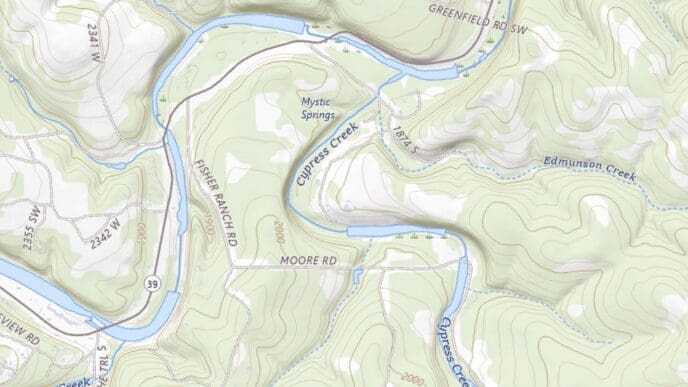NATIONAL REPORT – As the cost of a daily coffee continues its upward trajectory, a new study by coffee experts at Coffeeness sheds light on a surprising reality: the significant disparity in how long Americans across different states must work just to afford their morning cup of joe. The comprehensive analysis, published recently by Coffeeness, compares the average cost of a regular coffee and a Starbucks black coffee to each state’s average hourly wage, revealing stark differences in coffee affordability nationwide.
The study highlights that soaring coffee prices are influenced by a myriad of factors, including harvest yields, labor supply, and energy costs, forcing coffee shops to pass on rising overheads to consumers. Amidst these rising costs, Coffeeness sought to quantify the true “cost of coffee” in terms of minutes worked, discovering a variation of over four minutes between the most and least affordable states.
Hawaii: Paradise Comes at a Price for Coffee Lovers
According to the Coffeeness findings, Hawaii stands out as the state where a regular cup of black coffee is by far the most expensive. Averaging $4.98 per cup, a standard brew in the Aloha State costs over a dollar more than in California. Despite a relatively high average hourly wage of $37.88, Hawaiians must dedicate almost eight minutes (7.89 minutes, to be precise) of their workday to afford their daily caffeine fix. This means a single cup accounts for over 13% of an hour’s wages, making it the least affordable state for regular coffee.
Not far behind is Washington, where a regular coffee is the second most expensive. However, thanks to the state’s abundance of high-paying tech jobs, workers here boast some of the highest average hourly earnings in the U.S. This elevated income largely offsets the higher price, making a regular cup surprisingly affordable, requiring just 5.25 minutes of work.
The Heartland’s Brew: Where Coffee is Most Affordable
In stark contrast, the study identifies states in the American Heartland as havens for affordable coffee. Nebraska, in particular, leads the nation with the most budget-friendly regular coffee, costing an average of just $2.12. With an average hourly wage of $32.82, Cornhuskers need to work less than four minutes (3.88 minutes) to earn enough for their cup of joe. This makes a cup of regular coffee just 6.46% of the average hourly wage in the state.
Midwestern states like Michigan, Ohio, and Missouri also emerged as notably affordable. Even in Michigan, a state with high coffee consumption per capita, a regular cup requires only 5.1 minutes of work from an average hourly wage of $33.26. North Dakotans also enjoy favorable affordability, spending just 4.6 minutes working for their “black gold.”
The Desert’s Dry Spell: Affordability Challenges
The Coffeeness study also revealed challenging conditions for coffee affordability in the southwestern states. New Mexico, famed for its scenic beauty, ranks as the second least affordable state for a regular cup of coffee. While the average price of $3.31 isn’t the highest, a significantly lower average hourly wage of $29.10 means residents must sacrifice over 11% of their hourly income for a single cup. Neighboring Arizona faces similar struggles, where a cup of regular coffee demands 6.1 minutes of work, equaling 10.22% of the average hourly wage—a factor that may contribute to the state’s lower per capita coffee consumption.
High Wages Don’t Always Guarantee Coffee Bliss
Interestingly, the study points out that even in U.S. states boasting the highest average hourly incomes—such as Massachusetts ($42.65), Washington, California, and Colorado, all with hourly rates exceeding $40—more spending power doesn’t automatically translate to greater coffee affordability. For instance, Californians, despite high wages, must work nearly six minutes to afford a cup of regular coffee, a duration comparable to Arkansas, where the average hourly wage is more than $10 lower. Massachusetts, topping the income charts, still requires 4.91 minutes of work due to its relatively high coffee prices.
Starbucks: A Tale of Disproportionate Pricing
The Coffeeness study also delved into Starbucks coffee affordability, uncovering surprising price variances across states for a seemingly standardized global chain.
Arkansas again faces the steepest challenge, holding the title for the least affordable Starbucks cup in the nation. Residents here must put in well over 10 minutes of work to afford a black Starbucks coffee. Mississippi and New Mexico also see residents spending over 17% of their hourly wage on a Starbucks cup, a consequence of relatively low average wages coupled with high Starbucks prices.
Conversely, the nation’s capital, Washington D.C., offers the most affordable Starbucks coffee. Despite a high absolute price for a cup, D.C.’s exceptionally high average hourly wage ($42.65 for Massachusetts, D.C. is higher) means residents need only work 5.67 minutes to afford a Starbucks coffee, representing just 9.45% of their average hourly income. This contrasts sharply with Massachusetts, where a Starbucks cup requires nearly seven minutes of work.
Even Hawaii, known for its expensive regular coffee, shows a different picture for Starbucks. While a Starbucks cup still demands close to eight minutes of work, in comparison to other states’ Starbucks prices, Hawaii ranks among the most affordable, outranked by only nine others. This disparity highlights how local market dynamics can uniquely influence pricing across different coffee providers.
The study by Coffeeness underscores that while the daily coffee ritual is universal, the economic effort required to sustain it varies dramatically across the United States. Factors like local wages, state-specific pricing trends, and even the type of coffee shop chosen play a pivotal role in determining the true cost of a cup of joe in minutes worked, offering a unique perspective on regional economic well-being and daily budgets. For more details on the study’s methodology and state-by-state breakdowns, readers can visit the original source at Coffeeness.de.














